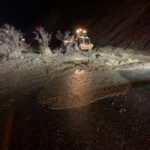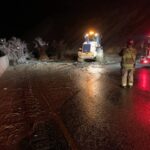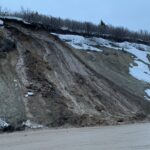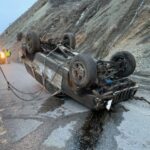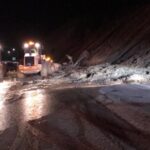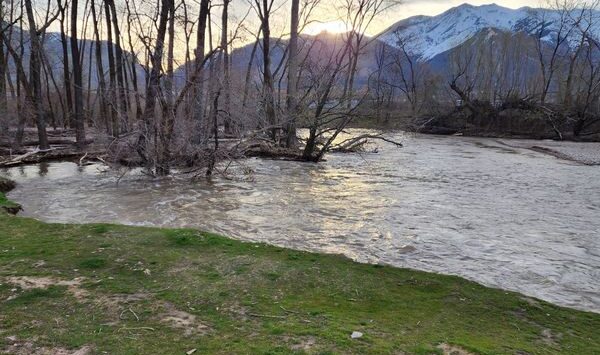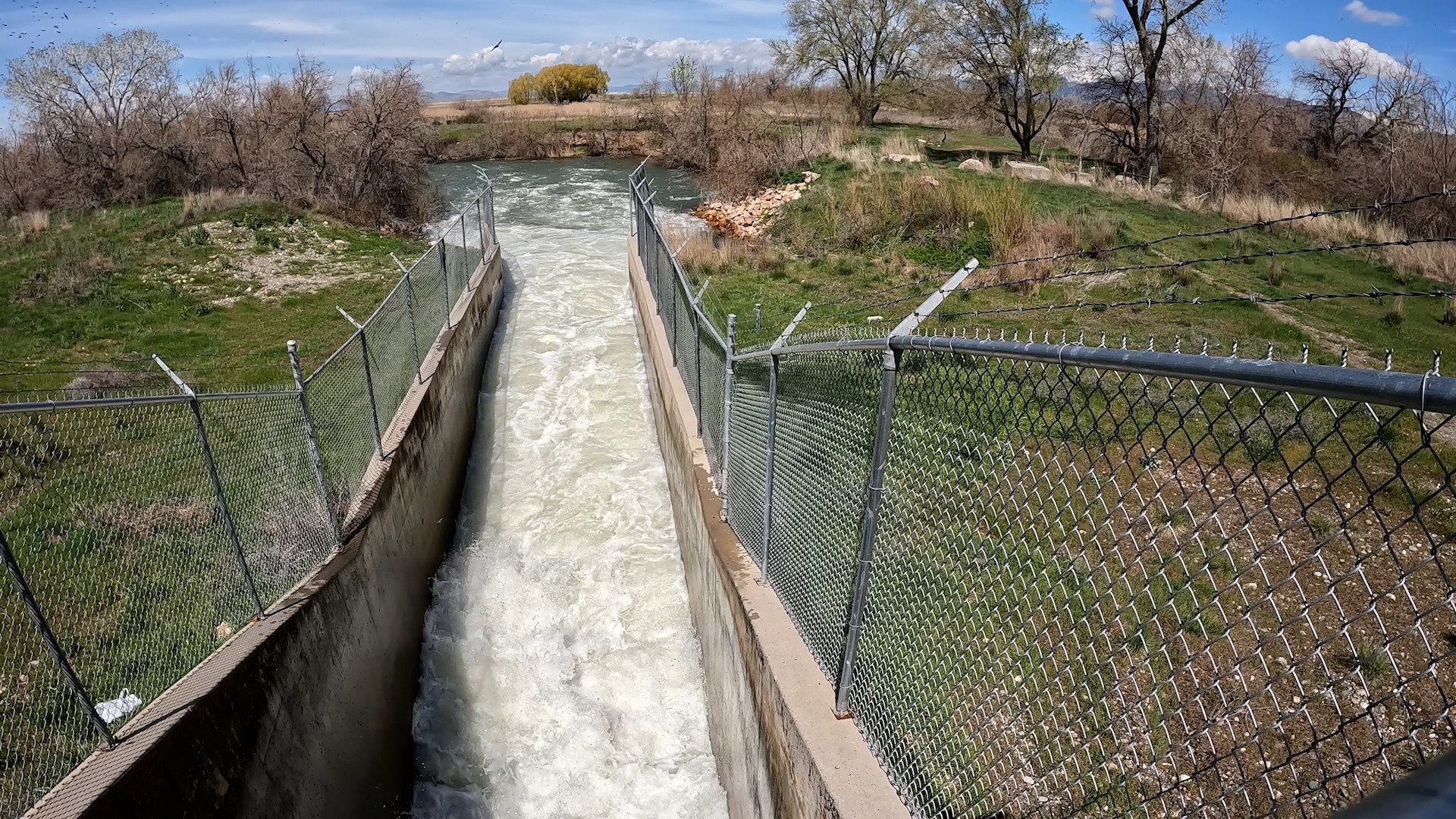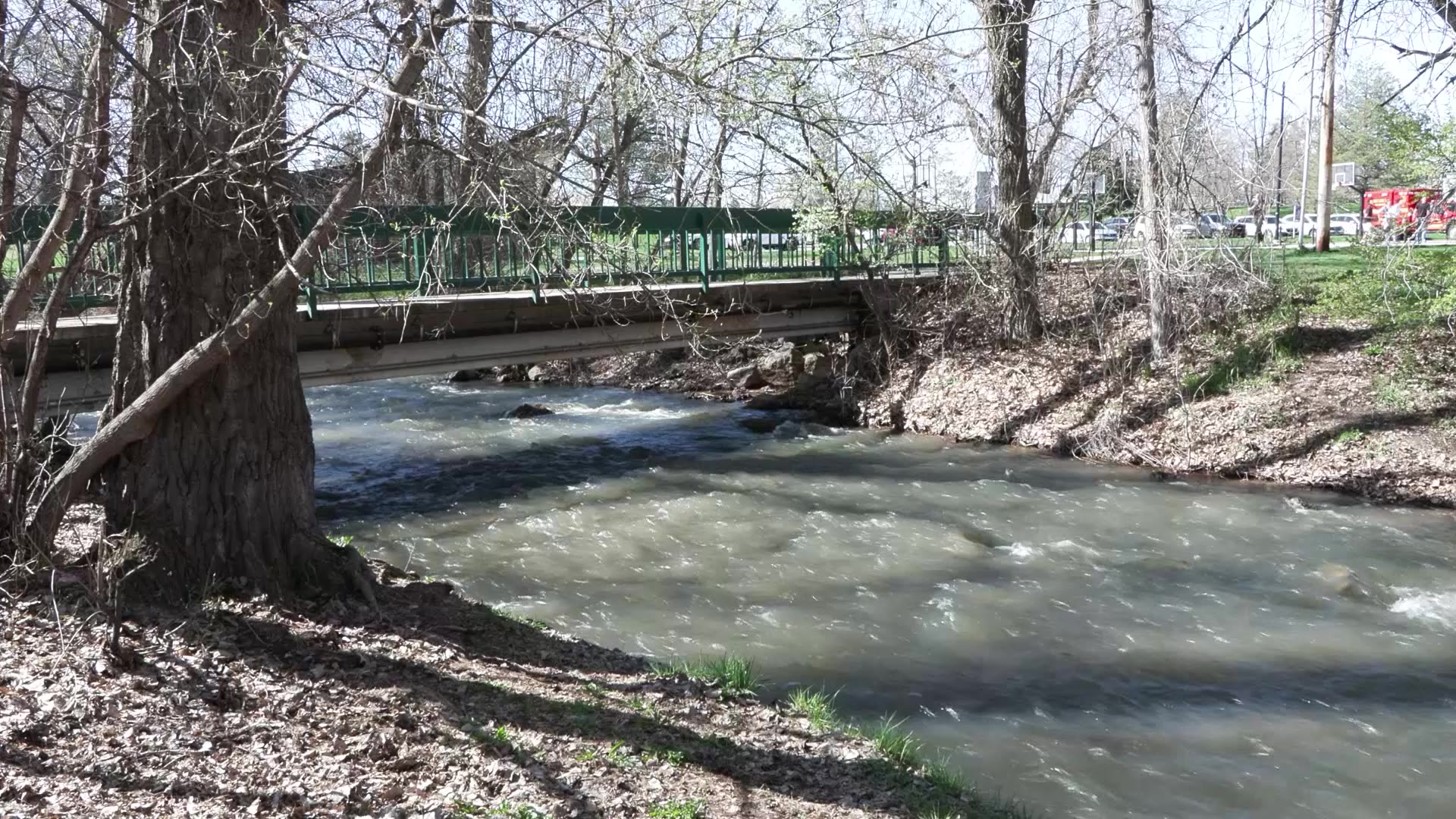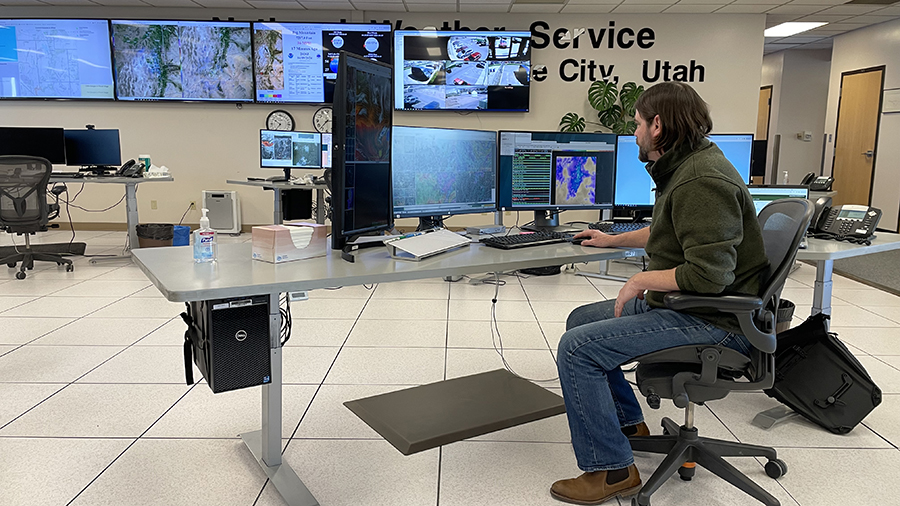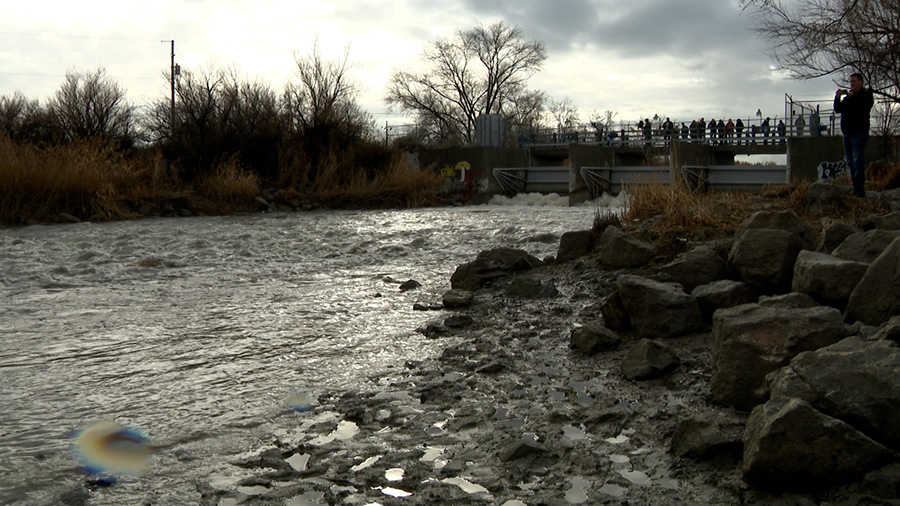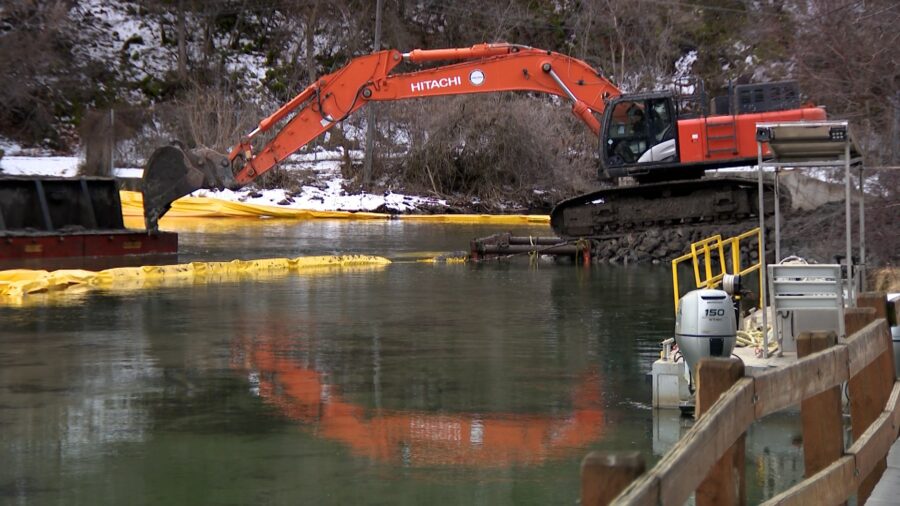Gov. Cox, state officials address flood mitigation efforts as floodwaters hit Utah neighborhoods
Apr 13, 2023, 1:52 PM | Updated: May 8, 2023, 5:09 pm
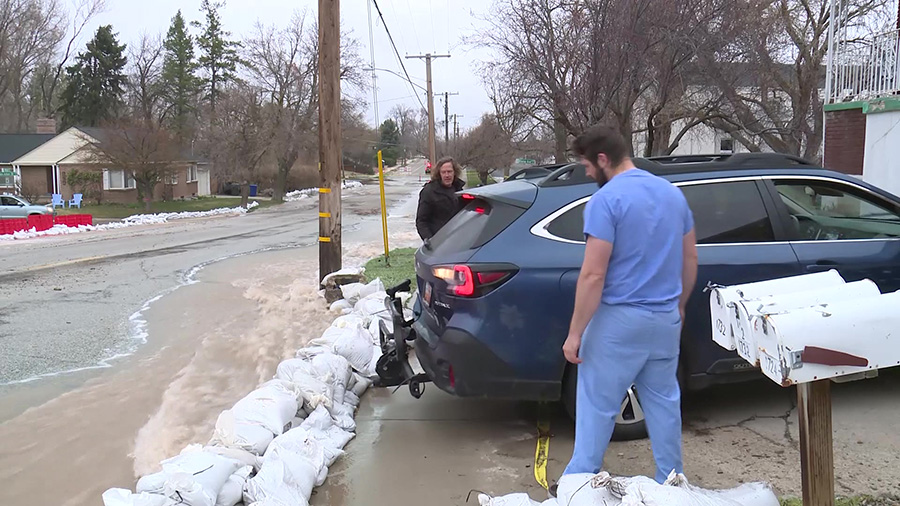
Floods across Utah have brought neighbors together to build walls of sand bags to irrigate the rushing waters down the street. (KSL TV)
(KSL TV)
SALT LAKE CITY — Gov. Spencer Cox was joined by a number of other state officials Thursday afternoon to discuss flood mitigation efforts across the state.
Among those that spoke during the press conference were:
- Gov. Spencer Cox
- Kris Hamlet, director of the Utah Department of Emergency Management
- Joel Ferry, executive director of the Utah Department of Natural Resources
- Kim Shelley, executive director of the Utah Department of Environmental Quality
- Carlos Braceras, executive director of the Utah Department of Transportation
- Craig Buttars, commissioner of the Utah Department of Agriculture and Food
Gov. Spencer Cox
Cox began by addressing the massive sinkhole in Kaysville, the mudslide up Parleys Canyon, the rockslide in Fairview Canyon, and the flooding from Emigration Canyon.
“We’re certain that these conditions will continue in the coming months. We are really just at the front end of getting all of that record water downstream where it needs to go,” he said.
Luckily, the temperatures dropped Thursday, allowing for a bit of reprieve from the flooding.
“Hitting in the 80s, that certainly got things moving, and once it starts moving, it’s really hard to slow it all down, so having three days in the 70s and low 80s certainly got it moving. This gives us a reset, and we’re hoping that these more moderate temperatures will continue moving forward. But again, we understand that floods are very likely as we continue, and we want people, citizens, counties and communities to continue to prepare for whatever might come over the next two-plus months,” Cox said.
He said the state has been working with cities and towns to ensure they have the funding to purchase necessary supplies. State and local agencies have also been coordinating to get equipment — including water pumps and sandbag machines — as well as clear drainages and culverts of debris.
“We… asked the legislature for $5 million in flood mitigation money before there was any snowstorms, and we ended up probably needing a lot more than $5 million, and so, we’re working with the legislature as we assess needs to figure out how much we will need. And they’re very open. Again, we have budgeted for rainy days for a long time, or snowy days, or flood days, or whatever it is we’re looking for, and these are the types of days we’ve been preparing for.”
As of Thursday afternoon, Cox said 1.4 million sandbags had already been sent out across the state. He then shared a message with all Utah residents.
“My message to Utahns is twofold. First, please do what you can right now to prepare. Again, we’ve had a pause now. You’ve seen where the water is coming, so we have a break in the action. Pay attention to local conditions. Stay away from fast-moving rivers and streams. Fill sandbags if you can. Ask for help if you need it. More information is available at floodhazards.utah.gov. Second, state employees, just a reminder, we issued an executive order allowing you to use administrative leave to help with flood efforts. If you’ve been thinking about doing that, and you’re in a position to help, we encourage you to take advantage of that administrative leave to help fill sandbags in your area, where needed.”
Gov. Cox issues executive order allowing state employees to help with flooding
Kris Hamlet, Utah Department of Emergency Management
“As was mentioned, the legislature, the governor’s office, the lieutenant governor have been really good to us as far as leaning forward, preparing for this inevitable event that we’re now just getting in to.”
Hamlet went on to say that almost every county in the state has received some sort of assistance, as of Thursday.
In addition to getting out sandbags, the DEM has been working to get heavy equipment to clean out waterways, culverts and other areas that might cause problems when the floodwaters come.
Hamlet also said the state has been recognized as having one of the nation’s best state disaster recovery accounts, which can be used by state agencies to help with natural disaster response.
DEM, which falls under the Utah Department of Public Safety, is responsible, as described by Hamlet, for all things preparedness, mitigation, response and recovery when it comes to emergency management.
“But it’s important to note that we can’t do it alone. We’re an agency of about 60 employees, and we rely heavily on our other state agency partners… when we activate our state emergency response, or our state EOC,” he said.
Worried about flooding? Where you can get sandbags to help with possible Utah floods
Hamlet said we’re currently at a level three enhanced level activation, but anticipate that the state will go to the next level soon “as we’re starting to see many of the jurisdictions declare local states of emergencies.”
“Because the governor was worried about flooding back in the fall, and we knew what was coming as well with all the snowpack and the conditions, we started working with our local emergency managers way before any of the flooding was going to start. And they’ve done an incredible job.”
Hamlet went on to say that safety is paramount.
“We want to make sure that people understand that those waters are cold; they’re fast; and if you wade in them, play in them, or step in them, you may get swept off your feet. And also, you don’t know what debris or hazardous materials might be in those waterways.”
Additional information — including flood insurance, flood mapping and flood preparedness — can be found here.
Joel Ferry, Utah Department of Natural Resources
Ferry started off by saying a lot of people are comparing what’s happening this year to what happened in 1983, 1984 and 1985. He then went on to explain what the state has done since then to prepare for a flooding situation like what we have going on now. Some of those things include:
- improved culverts
- improved infrastructure
- built several new reservoirs, like Little Dell Reservoir and Jordanelle Reservoir
“Even today, we’re in uncharted territory. When you look at the snow water equivalent that’s in the mountains, we are in still record-setting territory,” he said.
In referring to the 80s, he said spring runoff started in mid-May. This year, that’s starting the beginning to middle of April.
“In the 80s, it all came down at once. It heated up really quickly. So, what we’re hoping for is weather like we’re seeing today — where you have three or four days of warm water, four or five days, and then it cools down. So, the runoff starts, it picks up, but it’s going to slow down a little bit and we’re going to ease it through. And as we see these types of trends, we look at the forecast and we think that that will continue, but ultimately, we have to be prepared because what if it does warm up and stays warm?”
He again referred to being in unprecedented territory as we hit record-high snowpack in the state this season.
“This is unbelievable the amount of moisture that’s in the mountains, and so we’ve got to be prepared for that, because with that, it’s gotta come down. It will come down, and we’ve got to be really mindful of that.”
The good news, Ferry said, is most of our reservoirs are going to fill.
He said the state has been doing controlled releases at our reservoirs, letting the water out now so that when the peak runoff occurs, we can take the edge off, we can take that top level off and fill our reservoirs.
In addition to the surface flooding, Ferry said there’s concern for landslides. During the press conference, he said they were monitoring 100 active landslides in different areas of the state.
“These are serious events. These are serious times. The water has a lot of power. We need to be very mindful and we need to recognize how important our safety is and making sure people are aware of what’s going on and be safe.”
Kim Shelley, Utah Department of Environmental Quality
The DEQ, according to Shelley, is coordinating closely with both drinking water and wastewater systems across the state “to ensure that they are prepared for flooding and prepared to deploy necessary resources in the event that there is compromised wastewater infrastructure or drinking water sources.”
Shelley said the public has been asked to “err on the side of caution” when it comes to flood water and drinking water.
“It’s best to assume that all floodwater is contaminated with bacteria, viruses and chemicals,” she said.
She said if possible, avoid contact with flood water and definitely do not drink, swim or wade in the floodwater.
“If contact is unavoidable, we ask that you use common sense, wash your hands with soap and clean water, cover any open wounds with waterproof bandages, and disinfect the wound after coming into contact with the water.”
The public has also been asked to avoid recreational water impacted by flooding for 48 to 72 hours.
“Flooding can also overwhelm drinking water and wastewater infrastructure, leading to sewage backup into homes or wastewater treatment plants, and making water treatment more challenging.”
Shelley said the public can help prevent storm water infrastructure from becoming overwhelmed by removing debris in their gutters and storm drains.
Residents in areas that have been impacted by flooding were told to pay special attention to their drinking water.
“While some changes in drinking water’s taste, smell or appearance are normal, especially as the seasons change, if there’s flooding in your area, again, err on the side of caution. And do not drink or consume the water that doesn’t look, smell or taste normal. This is especially a risk for those who rely on well systems for drinking water.”
If there are concerns about your drinking water, Shelley said don’t wash your dishes, don’t brush your teeth, and don’t make food or baby formula with the water until you know it’s safe to consume.
Anyone with concerns about a water body or drinking water source was encouraged to call the DEQ at 801-536-4123.
Carlos Braceras, Utah Department of Transportation
Braceras began by saying UDOT has been preparing for this activity for months.
“As the snow’s been coming down, we’ve been realizing that we’re going to be dealing with it in two directions — while it came down; now as it’s going to be coming down the mountain as well.”
He said UDOT’s maintenance people have been working with local communities to help identify the areas that we need to work together on.
“You’ve heard a lot of this. We’re cleaning a lot of culverts, a lot of pipes, a lot of ditches. We’re looking for ways to make sure that when the water arrives, that it can run smoothly through, and then be prepared to remove that debris, because as you see logs and sticks come down, they clog the drains and things happen very, very quickly when that happens. So, we want to be able to respond to those as well.”
Thursday morning, Braceras said he was up in Little Cottonwood Canyon as some UDOT crews were working to clear some of the slides with bulldozers.
“It’s just, it’s amazing to see the size of the avalanches that are coming down. You’ve heard the word ‘unprecedented.’ It is absolutely unprecedented what we’ve seen in terms of snowfall and in terms of the way the snow has come at us and has stayed in those mountains. We’ve never really seen this much snow on the south facing — those are the slopes right over the roadway — before. Lots of debris and still a lot more work to do, so we ask people to be patient with us as we work to try to make sure it’s a safe road before we open it up to the public.”
He then referenced the recent mudslide up Parleys Canyon. He said crews cleared about 40 cubic yards of material that came down.
“We see no evidence that this is a deep-seated slide. This area has, in the past, experienced some very deep-seated slides that results in, you know, much more massive earth movements. We don’t expect this. We see this as a surface slide at this point.”
Braceras said UDOT expects additional material to keep coming down, adding that they have developed response plans for this based on the level of probability and the risk associated with that probability.
“I will say that across the state, we’re seeing evidence of water coming through the soil and coming out what we call our cut slopes — those slopes when they go up from the sides of the roads. We’re seeing that across the entire state. We have several areas that we are watching closely that we expect further erosion. And along with the land, the rockslides, the mudslides, we expect rockslides.”
He said about two Sundays ago, a very large rock came down on U.S. 6 in Price Canyon. Braceras said UDOT expects more activity in that canyon as we transition seasons.
Craig Buttars, Utah Department of Agriculture
“We’re seeing not only flooding coming down from the mountains, but a lot of flooding in our farm fields. And what this does is this flooding has impacted the ability of our farmers to get their crops planted. For example, our onion farmers, who usually have their seeds in the ground, you know, weeks ago, are going to be still weeks out from planting these crops. The problem with that is the early spring frosts can damage those crops and can, you know, cause the whole crop to be lost in the fall.”
In addition to that, Buttars said our cattlemen are experiencing a longer than normal period where they have to feed their cattle, adding that they’re going to have to hold their cattle in their feed lots before they let them out onto their grazing allotments because the grazing allotments are all in the mountains and they’re currently under snow.
He then described the hardship cattlemen are experiencing as they’re running low on feed, which is already expensive because of recent droughts.
“It’s very important that we grow hay and grow alfalfa in the state because during these times of disaster, that’s what keeps our cattle alive,” he said.


